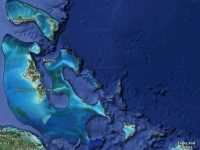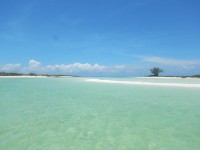We spent a few days in Culebra following our departure from the USVI as it was one of our favourites last year. We have since moved on and have spent a few days touring what we expect will be our final caribbean port for the season, San Juan.
Our sail from Culebra was a mix of wing-on-wing downwind sailing, motor sailing, thunder and lightning and eventually motor sailing upwind in light air as the storm cells over Puerto Rico reversed the prevailing easterlies. But the late afternoon was dry despite being overcast and we pulled the camera out for our arrival as we passed to the North of Old San Juan.

Making the entrance to the harbour, we passed Fort El Morro that protected the harbour for hundreds of years. Thankfully we encountered no cannon fire.

Magnus scoping out the shoreline of old San Juan.

With San Juan being a major city, we rented a car with the intention of grocery shopping, and to facilitate the completion of Magnus’ Bahamas paperwork, and of course for sightseeing. Unfortunately, our refrigeration has thrown a bit of a wrench in the plans for provisioning, so we skipped the groceries and focused on playing tourist.
Magnus hopefully enjoyed his couple of nights in air conditioning at the pet hotel, which allowed Chrissy and I to find the biggest caribbean mall. The sunlight and sunscreen have done a number on our clothes, so we both are in need of a few items to make our transition home without too many people thinking we are bums. Just need the discipline not to wear any of it for a few months.
Our second dog free day allowed us to visit El Morro and parts of Old San Juan which we otherwise would not have been able to do. Here is Chrissy standing at one of the gates to the old city.

El Morro is quite the historical fort and took over 200 years to build to it’s current state. This fort allowed Spain to remain control of San Juan for the better part of 300 years until the Americans managed to get their hands on it.

Here are the officers quarters.

The size of the fort was unlike any of the small ruins we had seen throughout the caribbean, although with the size of Puerto Rico and the resources available, it makes sense that would be a prize possession in those days. The arch on the left was the kitchen for the men, while their quarters were arranged opposite. The brickwork on this deck allowed a wide range of firing angles to be employed against enemy ships.

I can only imagine the man hours that went into building this fort. The slightly more modern concrete slits on the top were actually added during world war II to be used for a lookout and on the other end of the fort an anti-aircraft gun was installed to defend the city.

With cannon angles like this, I can understand why enemy ships weren’t able to squeeze through. We passed a few yards from the green buoy on our harbour approach and would have been an easy target.

The fort has a series of staircases for people to get around, but also had ramps for moving cannons around the various levels of the fort. The picture doesn’t do the angle of this ramp justice, I certainly wouldn’t have wanted to be at the bottom when a crew started to roll one down.

After the fort, we toured the old city, much preferring to walk than drive on the cobble stone roads.



After touring downtown, we went out for dinner in a newer part of town closer to the marina where we are currently docked. We set off planning to eat at one of two places, but in the end changed our mind at the last minute and were pleasantly surprised with live music, followed by a dj and dancing at the Blue Martini in San Juan.
We have since collected Magnus, taken him to the vet to have the official paperwork to depart for the Bahamas completed and he is now sporting a blue bandana that the vet gave him following his checkup.
As for the fridge, it quit a few days ago in Culebra and I woke up to find a defrosted fridge. As we actually had a spare controller, I swapped it in and we were back in business for 2 days until on our sail to San Juan, Chrissy called up to inform me that the ice was melting again. Of course it occurred on a Friday, so there was little to be done other than troubleshoot over the weekend.
My first thought was the compressor had a short or something that had just fried a second a controller and I should have checked the resistance on the motor connection before swapping the units, but it has turned out since that isn’t the case. The resistances are in spec and these compressors are reportedly very robust.
We noted that the compressor would attempt to start but then would kick off, so following all the troubleshooting advice out there, I rigged a new power cable direct to the main DC distribution (boat wiring can corrode due to the salt air and over time build resistance in the wiring which can cause voltage drops). After a few false starts we were in business again and off to the mall we went, the compressor amp draw being within spec.
Upon return, it was the same problem. All the resistances on the compressor motor checked out as they should, and with a new wire to the batteries and the shore power connected a low-voltage error on startup was ruled out. When running, the evaporator frosts over it’s entire surface, so we are not low on refrigerant.
The conclusion we’ve come to is that a blockage is forming where the high pressure refrigerant exits a small port into the evaporator. This could be from a small leak has drawn moisture into the refrigerant on the low pressure side of the system, and it freezes at the small port where the liquid refrigerant is pushed into the larger evaporator tubes. Or there could be some debris from internal degradation of the system causing the blockage. Either way, after a period of operation either the injection port freezes or constricts on the debris from thermal contraction. The result matches other well documented cases online from others who have had this problem. Magically, after the evaporator coil is warm, the unit will fire up again and works for anywhere from 2 hours to 2 days, although the frequency seems to be decreasing and the number of false start attempts before the compressor will run continuous is increasing.
The dilemma we’re faced with is that the cure for the moisture problem is reported as a ‘remdial’ solution. We can have the system refrigerant removed and replaced, but the water is usually significantly trapped in the oil that circulates with the refrigerant and can’t really be removed. The only way to get the moisture out is to maintain the system at ultra low vacuum pressures for hours to allow the water to boil out of the oil at ambient temperatures. Otherwise a typical evacation, purge and recharge of the system will have an unknown duration until the problem resurfaces. It could last 3 days to get us part way to the Bahamas where parts and services are extremely hard to find, or it could last months or years.
If it is actually debris blocking the tube instead of moisture, perhaps blocking flow as the tube/orifice contracts thermally around it, it could be dislodged by a refrigerant change and life could be back to normal fairly easily. But if it is because the internals of the system are starting to degrade with age I fear it could be the start of long path of throwing good money after bad, and the eventual replacement of at least the evaporator.
For about 3 times the cost of a service visit to do the full ‘remedial’ fix, or twice what it would cost to the full fix and install a desiccant filter to enhance the likelihood of a successful outcome we could buy a new system that draws 40% less power (the wonders of technological development). The system being modular and pre-charged, is a do-it-yourself install.
Two years ago, there would have been no decision. The power savings would have almost paid for the unit in reduced engine hours to charge the batteries, but as we head north, where the fridge doesn’t work so hard…. is it worth trying to be cheap?




A bit of a conundrum hmm. Hopefully you’ll be able to determine a solution. Lacking your engineering brain I would settle for canned and packaged food with fruit if you have the storage room.
Safe travels Nan ?
Sometimes I think I should just call ‘the guy’, and save myself a lot of aggravation. I currently have a new fridge in an unopened box, and now am convinced that my original diagnosis is wrong. I just need to recharge the system. So now I have a can of refrigerant on the table, and hopefully tomorrow have the refill hose in my hand…. On the bright side, the total outlay wont be more than a service visit after I ship the new fridge back, and ‘the guy’ couldn’t come until next week anyway.